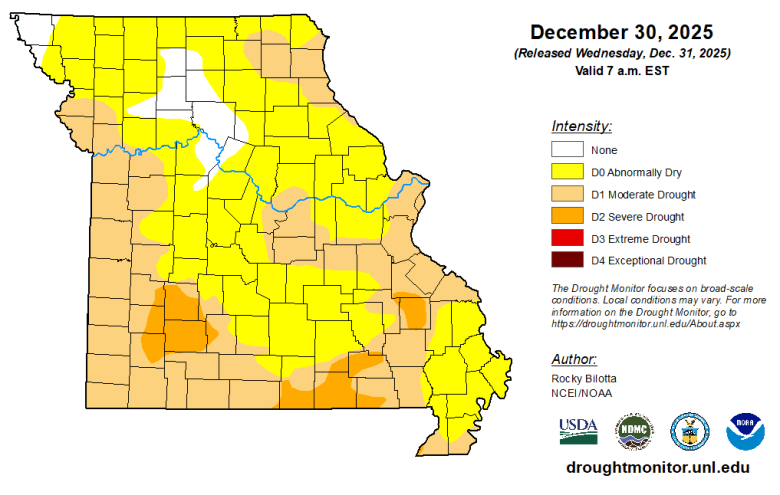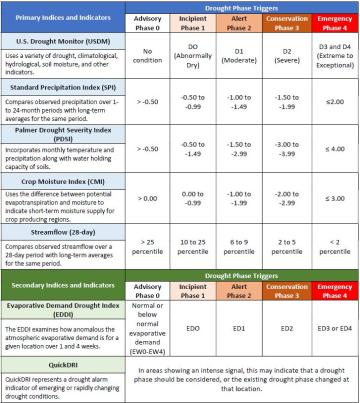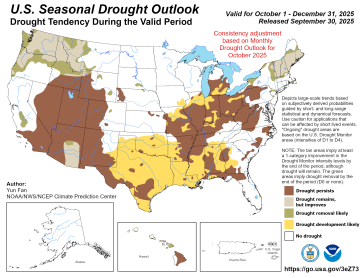
The amount of precipitation in a particular area varies from year to year, but over a period of years the average amount is fairly constant. A drought is a period of drier-than-normal conditions that results in water-related problems and other issues. When little or no rain falls, soils can dry out, plants can die and livestock can suffer. When dry weather persists, stream and river flows can decline, water levels in lakes and reservoirs can fall and water in wells and aquifers can decline. Drought can have a serious impact on health, agriculture, economies, energy and the environment.
Droughts can develop quickly or gradually over several weeks, months or even years, and worsened with extreme heat or wind. A drought can end just as quickly or gradually as it began, but more commonly persist for months. A single rainstorm may provide temporary relief, but its impact is short term. Thunderstorms often produce large amounts of rain in a very short time, causing the rain to run off into streams rather than soak into the ground. Several soaking rains may be required to recharge groundwater and break a drought.
Reporting Drought Conditions
Reports and photographs are essential tools used to assess drought conditions. The department encourages the public to submit information and photographs about conditions in their area in order to help local, state and national decision-makers assess drought conditions and impacts in Missouri. If you would like to submit drought-related conditions and impacts for your area, please fill out the survey form at Condition Monitoring Observer Reports (CMOR)*
Tips and best practices for using CMOR, including how to download and use its field app, is available int he troubleshooting guide below. Additional information also is provided to learn how CMOR reports help the department achieve its goals. Please note, those uploading photos to CMOR using newer iPhones will need to change their photo format settings to “most compatible” to successfully add images. Users also don’t need a user account to submit CMOR reports, and can “continue without logging in” to proceed.
- CMOR troubleshooting guide
- MoDNR video training
- MoDNR CMOR presentation
- NDMC CMOR Overview Presentation
*The survey is a nationwide service developed by the National Drought Mitigation Center, based at the University of Nebraska, in partnership with the National Integrated Drought Information System and the U.S. Department of Agriculture.
News
Gov. Mike Kehoe signed Executive Order 25-29 on Sept. 22, 2025, declaring a drought alert in Missouri effective until Dec. 1, 2025. The decision comes following expert analysis by the Climate and Weather Committee. The committee will continue to meet regularly to monitor conditions according to the state's Missouri Drought Mitigation and Response Plan. The department encourages the public to submit information and photographs about conditions in their area in order to help local, state and national decision-makers assess drought conditions and impacts in Missouri. If you would like to submit drought-related conditions and impacts for your area, please fill out the survey form at Condition Monitoring Observer Reports (CMOR).
News
- Governor Kehoe Signs Executive Order 25-29 Declaring Drought Alert in Missouri
- Drought Assessment Committee holds first meeting of 2025
Advisories/ Executive Orders
- Governor Extends Executive Order 25-29 until April 1, 2026 - EO 25-34
- Governor Declares a Drought Alert in Missouri until Dec. 1, 2025 - EO 25-29
- County Burn Bans in Missouri - Missouri Department of Public Safety
Assistance
The more proactive we are, the better we can help our farmers and citizens lessen the impact of even the most severe droughts. Listed below are resources currently available to assist our communities. Any additional resources will be added as they become available. For general information about responding to and recovering from a drought, please refer to the Drought section on the department's Disaster Response and Recovery webpage.
Agriculture
- Water Opportunities - Missouri State Parks is providing free access to water for livestock producers at select boat ramp locations. Farmers will need to provide their own pumping and hauling equipment to fill their water tanks during normal park hours.
- Hay Directory - Missouri Department of Agriculture
- Hay Hauling Overwidth Permit - The Missouri Department of Transportation is offering a special overwidth hauling permit at no charge to help farmers and ranchers move hay as needed.
- Feedstuff Finder - An online tool enabling feedstuff buyers and sellers to make connections on feedstuff sources by location, prices and product type.
- Landowners wanting information about incorporating warm-season native grasses into their grazing systems can contact their local Missouri Department of Conservation office or MU Extension office. More information about the grazing benefits of native warm-season grasses can be found at mdc.mo.gov.
- USDA Drought Resources - Has your agricultural operation been impacted by drought? USDA offers programs that can help with recovery as well as those that can help you manage risk and build resilience on your operation. Visit the USDA's Service Center Locator webpage to find your county’s contact or service center office.
- Emergency Farm Loans - The U.S. Department of Agriculture, Farm Service Agency's Emergency Loan Program is available to help eligible farmers and ranchers rebuild and recover from sustained losses. Emergency loans can be used to meet various recovery needs, including replacing essential items such as equipment or livestock, reorganizing a farming operation or refinancing certain debts. Visit the USDA's national Emergency Designations webpage for more information on the disaster declaration process.
- MU Extension - Information on various drought resources and connections to local specialists offering assistance is available to farmers through MU Extension.
- Tax implications of forced cattle sales amid drought - Drought and high feed prices forced many producers to sell off part of their beef herd to survive. Congress recognizes the impact weather can have on producers, and has two special tax provisions to reduce income tax liabilities. However, consult your income tax professional first to assess your situation because it might cost you more in the future.
- Feeling the weight of farm stress? Get confidential support 24/7 from friendly specialists who understand agriculture through the Missouri Department of Agricultures' AgriStress Helpline.
- Landowners should contact their local county soil and water conservation district office for additional information and assistance.
Energy
Public schools (K-12), public colleges and universities, city and county governments and public hospitals impacted by severe weather events or catastrophic equipment failure may apply for low-interest emergency energy loans to replace or upgrade damaged equipment. Applicants must submit their application within two months of the weather event. For more information, visit Emergency Energy Loans.
Water
For water supply concerns or questions, water systems should contact the department’s Public Drinking Water Branch for more information.
- Drinking Water Emergency Exception Request MO 780-2821 - Public water supply systems may obtain a fast track waiver allowing construction of infrastructure projects, ensuring a sufficient supply of safe water to customers.
Wildfire Prevention
During times of drought wildfire prevention is of key importance for public safety. Resident should be mindful when driving off road, building campfires or burning leaves and other debris. It also is essential for smokers to put out cigarettes completely and safely, as well as responsibly dispose of butts. More information is available at the Missouri Department of Conservation’s Wildfire Prevention webpage
Visit the National Weather Service’s Fire Weather Outlooks webpage before conducting any prescribed burns on your property, or other activities that may ignite a wildfire. Resources to support prescribed burns are available at the Missouri Department of Conservation’s Prescribed Fire webpage. Additional information on wildfire prevention can also be found at the Missouri Department of Public Safety’s Missouri Natural Cover Fire Risk webpage.
Drought Types
Flash drought
Drought can also develop rapidly, in what is referred to as flash drought. In addition to the lack of precipitation associated with conventional drought, flash droughts are often driven by abnormally high temperatures, winds, and/or incoming solar radiation, which leads to high evapotranspiration (ET) rates.
Meteorological Drought
In most of the central United States, a meteorological drought may be defined by deficiencies in monthly or seasonal precipitation. Additionally, a meteorological drought may also be characterized by higher-than-average temperatures, high winds, low relative humidity, and less cloud cover.
Hydrological Drought
A hydrological drought is measured by declines in streamflow, lake levels, or groundwater levels. Hydrological drought is often measured on a watershed or river basin scale. While a hydrological drought originates with a meteorological deficit in precipitation, it is measured based on the impacts to the hydrologic system. Generally, hydrologic impacts and deficiencies lag meteorological and agricultural indicators. For example, it may take several months for precipitation deficiencies to cause declines in reservoir levels.
Agricultural drought
An agricultural drought may be determined by a combination of precipitation shortages; soil water deficits; reduced stream, lake, and groundwater levels; and other factors that impact crops and livestock. Soil water deficiencies in an agricultural drought may lead to plant water stress and reduced biomass and yield.
Socioeconomic drought
A socioeconomic drought considers the impacts of meteorological, agricultural, or hydrologic droughts on supply and demand of economic goods. Socioeconomic drought occurs when there is a weather-related shortfall in water supply that is exceeded by the demand for water to meet an economic need. All regions of the state may experience a socioeconomic drought, although the economic drivers and impacts in each region are likely to differ.
Ecological drought
An ecological drought is a deficit in water availability that drives ecosystems beyond thresholds of vulnerability, impacts ecosystem services, and triggers feedback in natural and/or human systems. Ecological drought impacts may include reduced biodiversity, forest conversion, fish kills in streams, river degradation, and/or species migration.
For more information on drought types and common short- and long-term impacts, please refer to section 2 of the Missouri Drought Mitigation and Response Plan.
Drought Plan
After more than two years of study and development, the department replaced the previous 2002 Drought Plan with the 2023 Missouri Drought Mitigation and Response Plan, which uses modern tools for enhanced monitoring and assessment of all types of droughts. It also gives everyone from government officials, to water users, water suppliers and leaders of industry guidance for adopting water conservation best practices to grow their drought resiliency. The main goals of the Missouri Drought Mitigation and Response Plan are serving as an information source for reducing drought impacts, increasing public awareness, enhancing resiliency, promoting water conservation, improving monitoring, facilitating response planning, as well as clarifying roles and responsibilities.
A key component of the Missouri Drought Mitigation and Response Plan is a matrix of drought mitigation actions and strategies. The matrix of over 100 actions and strategies is intended to aid state, federal, and local government officials; commercial, industrial, and private water users; and public and private water suppliers in both planning for and responding to drought events in Missouri. Some of the actions and strategies presented in the matrix have already been implemented and have been proven to be useful in mitigating impacts. Others should be considered for implementation prior to or in response to future droughts.
As described in the plan, Missouri’s Drought Response System has been divided into five phases to provide for a measured response to worsening effects of drought, typically on a county-by-county basis. This drought monitoring and assessment system provides for state and local planners to proactively coordinate and take action to raise awareness and mitigate the effects of drought. The five phases, which guide state-level government actions and responsibilities, include:
- Phase 0 – Advisory Phase: MoDNR, in consultation with the State Climatologist, conducts weekly reviews of the drought indices and indicators, and other climate conditions and forecasts. The advisory phase continues if indices and indicators show no evidence of emerging drought conditions.
- Phase 1 – Incipient Phase: When climate forecasts and primary indices and indicators signal that dry conditions are possible in the coming months, MoDNR activates the Climate and Weather Committee (CWC) and notifies the MoDNR department director that a worsening of conditions may warrant activation of the Drought Assessment Committee (DAC). Emerging or rapidly changing conditions, as observed using the secondary indices, can also trigger movement into this phase and the potential activation of the DAC at the discretion of the director. Incipient phase conditions correlate to the USDM D0 category representing abnormally dry conditions. Monitoring and consideration of the indices and indicators should accelerate if conditions approach or enter the alert phase.
- Phase 2 – Alert Phase: The alert phase is declared when the CWC recognizes worsening but still moderate drought conditions. The MoDNR department director requests the governor make a drought declaration for the counties or regions of the state experiencing alert phase drought conditions, which correlate to the USDM D1 category representing moderate drought. The declaration of a drought alert by the governor directs state agencies to work together in providing as many resources and as much assistance as possible to impacted communities. The Drought Assessment Committee is activated and populated by representatives from key state and federal agencies and supported by input from stakeholders representing impacted counties or regions. Impact teams (ITs) may be formed to interact with key stakeholders and assist in data gathering and review.
- Phase 3 – Conservation Phase: The conservation phase is declared when the CWC recognizes worsening drought conditions and forecasts indicate an extended period of below-normal precipitation, suggesting actions to conserve water are warranted. The MoDNR department director requests the governor make a drought declaration for the counties or regions of the state experiencing conservation phase drought conditions, which correlate to the USDM D2 category representing severe drought. The DAC empowers the ITs to encourage impacted areas to implement water conservation and take other plan-recommended actions and strategies to reduce demand and conserve supplies.
- Phase 4 – Drought Emergency: The emergency phase is declared when the drought conditions enter the USDM D3 (extreme) and D4 (exceptional) categories and forecasts indicate continued below-normal precipitation, suggesting emergency actions are necessary to support essential water uses and protect public health. The MoDNR department director may request the governor make a drought declaration for the counties or regions of the state experiencing emergency phase conditions. The governor activates the Drought Executive Committee independently or upon recommendation of the DAC. The Missouri Department of Agriculture may draft an executive order for an agricultural disaster declaration and a Health and Public Safety Declaration may be drafted by the Missouri Emergency Management Association.
Missouri Conditions
- Missouri Drought Map - National Drought Mitigation Center
- Missouri Drought Map: Compare Two Weeks - National Drought Mitigation Center
- Drought Condition Monitoring Observer Reports Map - National Drought Mitigation Center
- Missouri Climate Center - University of Missouri
- County Burn Bans in Missouri - Missouri Department of Public Safety
Water Levels
- Groundwater Levels
- Current Conditions for Missouri: Groundwater - U.S. Geological Survey
- Streamgages
- Missouri Streamflow Conditions - U.S. Geological Survey
- Current Lake Levels
- Current Conditions for Missouri: Lakes and Reservoirs - U.S. Geological Survey
Precipitation
- Current Conditions for Missouri: Precipitation - U.S. Geological Survey
- Missouri Radar (Intellicast) - Weather Underground
- National Weather Service Weather Forecast Office | DVN - Quad Cities, IA/IL
- National Weather Service Weather Forecast Office | EAX - Kansas City/Pleasant Hill, MO
- National Weather Service Weather Forecast Office | PAH - Paducah, KY
- National Weather Service Weather Forecast Office | SGF - Springfield, MO
- National Weather Service Weather Forecast Office | LSX - St. Louis, MO
Nationwide Conditions
- U.S. Drought Monitor - Nationwide - National Drought Mitigation Center
- Climate Prediction Center Outlook - National Weather Service
- U.S. Seasonal Drought Outlook - National Weather Service
- National Forecast Maps - National Weather Service
Popular Links
Navigation
Contact Information
Water Resources Center
Missouri Geological Survey
P.O. Box 176
Jefferson City, MO 65102-0176
United States




